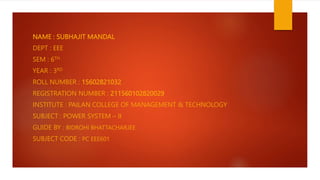
Subhajit Mandal_Power System II.pptx
- 1. NAME : SUBHAJIT MANDAL DEPT : EEE SEM : 6TH YEAR : 3RD ROLL NUMBER : 15602821032 REGISTRATION NUMBER : 211560102820029 INSTITUTE : PAILAN COLLEGE OF MANAGEMENT & TECHNOLOGY SUBJECT : POWER SYSTEM – II GUIDE BY : BIDROHI BHATTACHARJEE SUBJECT CODE : PC EEE601
- 2. One-line (single-line) diagrams ALMOST ALL MODERN POWER SYSTEMS ARE THREE-PHASE SYSTEMS WITH THE PHASES OF EQUAL AMPLITUDE AND SHIFTED BY 120˚. SINCE PHASES ARE SIMILAR, IT IS CUSTOMARY TO SKETCH POWER SYSTEMS IN A SIMPLE FORM WITH A SINGLE LINE REPRESENTING ALL THREE PHASES OF THE REAL SYSTEM o Generation o Transmission network To transport the electric power from the point of generation to the load centers. All above a certain voltage .
- 3. o (SUB TRANSMISSION) DISTRIBUTION NETWORK To distribute the electric power among the consumers Below a certain voltage. SUBSTATION A SUBSTATION IS A PART OF AN ELECTRICAL GENERATION, TRANSMISSION, AND DISTRIBUTION SYSTEM. SUBSTATIONS MAY BE OWNED AND OPERATED BY AN ELECTRICAL UTILITY, OR MAY BE OWNED BY A LARGE INDUSTRIAL OR COMMERCIAL CUSTOMER. CROSS ARM The woods most commonly used for crossarms are Douglas Fir or Longleaf Southern Pine because of their straight grain and durability. The top surface of the arm is rounded so that rain or melting snow and ice will run off easily.
- 4. INSULATOR An electrical insulator is a material whose internal electric charges do not flow freely, and therefore make it very hard to conduct an electric current under the influence of an electric field. A perfect insulator does not exist, but some materials such as glass, paper and teflon, which have high resistivity, are very good electrical insulators. TYPES OF INSULATORS PIN TYPE INSULATOR SUSPENSION INSULATOR STRAIN INSULATOR SHACKLE INSULATOR PIN TYPE INSULATOR As the name suggests, the pin type insulator is mounted on a pin on the cross-arm on the pole. There is a groove on the upper end of the insulator. The conductor passes through this groove and is tied to the insulator with annealed wire of the same material as the conductor. Pin type insulators are used for transmission and distribution of electric power at voltages up to 33 kv. Beyond operating voltage of 33 kv,
- 6. SUSPENSION INSULATOR For Voltages Greater Than 33 Kv, It Is A Usual Practice To Use Suspension Type Insulators Shown In Figure. Consist Of A Number Of Porcelain Discs Connected In Series By Metal Links In The Form Of A String.
- 7. STRAIN INSULATOR A Dead End Or Anchor Pole Or Tower Is Used Where A Straight Section Of Line Ends, Or Angles Off In Another Direction. These Poles Must Withstand The Lateral (Horizontal) Tension Of The Long Straight Section Of Wire. In Order To Support This Lateral Load, Strain Insulators Are Used. For Low Voltage Lines (Less Than 11 Kv).
- 8. SHACKLE INSULATOR In Early Days, The Shackle Insulators Were Used As Strain Insulators. But Now A Day, They Are Frequently Used For Low Voltage Distribution Lines. Such Insulators Can Be Used Either In A Horizontal Position Or In A Vertical Position. They Can Be Directly Fixed To The Pole With A Bolt Or To The Cross Arm.
- 9. CONDUCTOR :- A Conductor Is An Object Or Type Of Material That Permits The Flow Of Electrical Current In One Or More Directions. For Example, A Wire Is An Electrical Conductor That Can Carry Electricity Along Its Length.
- 10. THANK YOU